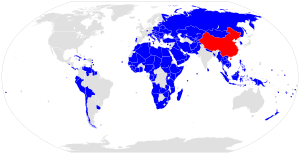Cooperation between China and Central and Eastern European Countries
Cooperation between China and Central and Eastern European Countries (China-CEE, China-CEEC, also 17+1, formerly 16+1) is an initiative by the Chinese Ministry of Foreign Affairs to promote business and investment relations between China and 17 countries of CEE (CEEC) – Albania, Bosnia and Herzegovina, Bulgaria, Croatia, Czech Republic, Estonia, Greece, Hungary, Latvia, Lithuania, North Macedonia, Montenegro, Poland, Romania, Serbia, Slovakia and Slovenia.[1][2]
Format
The format was founded in 2012 in Budapest to push for cooperation of the "17+1" (the 17 CEE countries and China). The 17+1 meet annually; summits were held in Dubrovnik (2019), Sofia (2018), Budapest (2017), Riga (2016), Suzhou (2015), Belgrade (2014), Bucharest (2013) and Warsaw (2012). The China-CEE secretariat is in Beijing, with 17 "national coordinators" in each of the partner CEE countries.[3]
The format's goals are to promote the Chinese Belt and Road Initiative and enhance cooperation in the fields of infrastructure, transportation and logistics, trade and investment".[4][5] These goals are supported by "growing ties in the areas of culture, education and tourism ... cultural exchanges, think tanks and NGOs."[4]
Infrastructure, investment and trade
This includes (as of 2017) Serbia's E763 Highway project, the Budapest-Belgrade railway and the China-Europe land-sea express line. In Croatia, a contract to build the first phase of the Peljesac bridge and its access roads, signed by a Chinese consortium led by China Road and Bridge Corporation (CRBC). In Poland, the acquisitions of Huta Stalowa Wola civil engineering machinery division and KFLT Bearings Poland by Chinese companies. According to China Customs’ statistics, China's trade volume with CEEC totaled $67.98 billion in 2017, a 15.9 percent increase compared to that of 2016.[4] According to the Chinese Ministry of Commerce, in 2016 China-CEE trade increased to $58.7 billion (from $43.9 billion in 2010), while its investment in CEE countries has accumulated to more than $8 billion, covering industries such as machinery, chemical, telecom and new energy.[5]
Cultural links
From 2012 to 2017 six new direct flight routes between China and CEEC has been opened, the number of Chinese tourists visiting CEEC increased from 280,000 to 930,000, and the number of exchange students doubled as well[provide figures]. A China-CEEC Coordination Center for Cultural Cooperation was opened in North Macedonia. In China, the China-CEEC training center for young artists and China-CEEC Cultural and Creative Industries Exchanges and Cooperation Center were opened in the southwestern city of Chengdu.
EU opposition
China says the initiative is a ‘win–win’ cooperation for the countries involved and the EU. European think tanks have raised the view that China is pursuing an assertive strategy of ‘divide and conquer’ designed to benefit China at Europe's expense.[6]
References
- "Chinese '16+1' Initiative to Be Called '17+1' after Greece Joins Group". N1. April 13, 2019. Retrieved October 26, 2019.
- Introduction of the Secretariat for Cooperation between China and Central and Eastern European Countries, on the china-ceec.org web (2013/11/20)
- National Coordinators on the china-ceec.org web
- ‘16+1’ mechanism set to bolster China-Europe ties, on the china-ceec.org web (2018/07/10)
- Cooperation between China and Central and Eastern Europe: Promising Start, Doubtful Outlook, by Ágnes Szunomár, China-US Focus, December 6, 2017
- China’s Economic Diplomacy in Central and Eastern Europe: A Case of Offensive Mercantilism?, by Jeremy Garlick, Europe-Asia Studies, online September 2019
Publications
- China's Relations with Central and Eastern Europe: From "Old Comrades" to New Partners, Edited by Weiqing Song, Routledge, October 2017
- Central and Eastern Europe as a New Frontier of China's Multilateral Diplomacy, Guest Editor: Dragan Pavlićević, Global China and Symbolic Power: The Case of 16 + 1 Cooperation, by Anastas Vangeli, Journal of Contemporary China, 11 April 11, 2018, https://doi.org/10.1080/10670564.2018.1458056
- China's Engagement with the Sixteen Countries of Central, East and Southeast Europe under the Belt and Road Initiative, by Anastas Vangeli, 19 September 19, 2017, https://doi.org/10.1111/cwe.12216, in: China & World Economy, Volume 25, Issue 5, Special Issue: Eurasian Perspectives on China's Belt and Road Initiative, September–October 2017, Pages 101-124
- The New Silk Road: China Meets Europe in the Baltic Sea Region – A Business Perspective, Edited by Jean-Paul Larçon (HEC Paris, France), World Scientific, July 2017
- Romanian rhetoric on China's 16+1. Diffraction of politics and economics at Babeș-Bolyai University of Cluj-Napoca (Romania) by Radu Sava , November 2019.
- Andreea Brînză, The “17+1” Mechanism, Caught Between China and the United States, China Quarterly of International Strategic Studies, Vol. 05, No. 02, pp. 213-231 (2019), https://doi.org/10.1142/S237774001950009X
External links
- Website of the Cooperation between China and Central and Eastern European Countries
- in English: www
.china-ceec .org /eng / - and Chinese: www
.china-ceec .org
- in English: www
